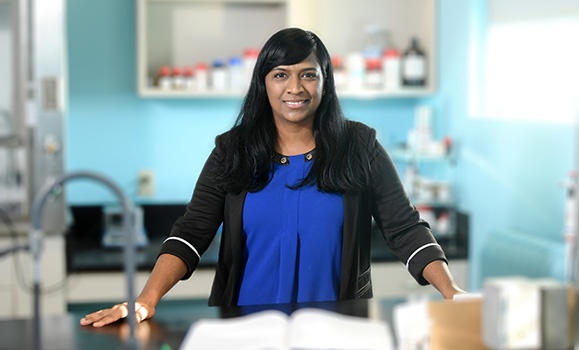–¬º”∆¬¡˘∫œ≤ ø™Ω±÷±≤• researcher Dr. Mita Dasog has received a $50,000 USD award to kick-start a project that could revolutionize the technology used to extract carbon dioxide directly from the atmosphere.
Earlier this month, Research Corporation for Science Advancement (RCSA), a private foundation that funds basic research in the physical sciences at institutions across Canada and the United States, seven team projects funded in the third year of the (NES) initiative. Nineteen early-career researchers will receive individual awards of $50,000 USD, including Dr. Dasog and her project collaborator, Dr. Kandis Leslie Abdul-Aziz of the University of California, Riverside.
Scialog projects are funded by RCSA, the ClimateWorks Foundation and the Alfred P. Sloan Foundation, which funded the project by Drs. Dasog and Abdul-Aziz.
‘This prestigious Scialog funding decision is another resounding endorsement of the cutting-edge ideas and technologies being pioneered by Dr. Dasog and her research group,” says Dr. Chuck Macdonald, dean in the Faculty of Science. “The pursuit and development of cleaner and more sustainable technologies is one of our key priorities and Dr. Dasog is a true leader in helping us work toward achieving this goal.”
Forming a partnership
Ã˝
, which is short for “science + dialog,” was created in 2010 by RCSA. Scialog Fellows are selected to take part in multi-year initiatives where they are encouraged to form multidisciplinary teams and take innovative approaches to address scientific challenges of global significance. The Scialog: NES initiative aims to catalyze advances in basic science that will enable technologies for removal of CO2 and other greenhouse gases. Last summer Dr. Dasog, an associate professor in the Department of Chemistry, was selected as one of 50 NES Fellows in North America and invited to attend November’s meeting of NES Fellows in Tucson, Arizona, where the idea for the project came together.
Though they hadn’t previously met, Drs. Dasog and Abdul-Aziz realized their research groups had complementary skill sets, making them an ideal match to collaborate on a project that encourages partnerships from interdisciplinary teams.
Titled “Sunlight Driven CO2 Capture and Release,” the project seeks to develop more energy-efficient direct air capture (DAC) technology, which removes carbon dioxide gas directly from the atmosphere and stores it for long-term disposal or use in industrial applications.
“The DAC process is currently very energy-intensive due to the thermal treatment required to regenerate the capture material,” explains Dr. Dasog. "Using conventional energy sources to regenerate DAC systems would defeat the purpose of removing CO2 from the atmosphere.”
The two researchers realized that their respective strengths would make them ideal partners.
“Dr. Abdul-Aziz’s research group has expertise in designing carbon capture materials and direct air capture (DAC) systems,” says Dr. Dasog. “Our group knows how to harvest sunlight and convert it to other forms, like heat. “
Though the project is in its very early stages, Dr. Dasog is looking forward to getting started. Hearing the project was being funded sparked “a mixture of shock, happiness and gratitude,” she says. “It was already such an honour to be chosen as a Fellow and to watch the pitches from the other talented researchers. To have our project funded among so many great ideas is a true delight.”

